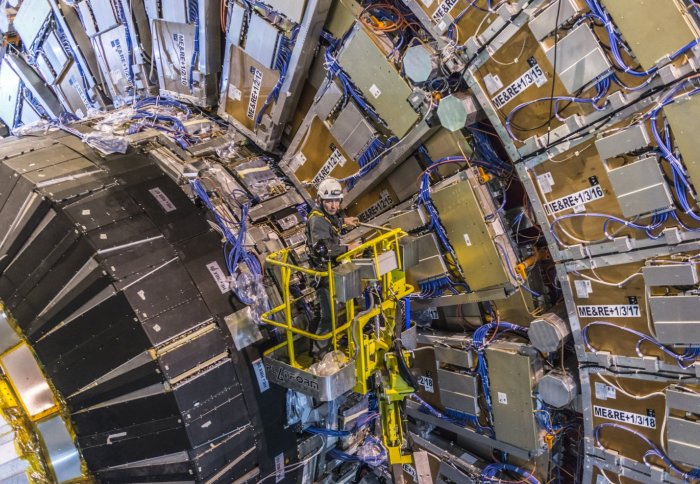
Compact Muon Solenoid detector at Large Hardon Collider

Imperial physicists and visitors will be exploring the discovery of the Higgs boson at this year's Royal Society Summer Science Exhibition.
In July 2012, researchers working on the Large Hadron Collider confirmed that they were 99.999 per cent certain they had found the elusive Higgs boson particle first theorised by Peter Higgs, François Englert and Imperial’s Professor Tom Kibble back in the early 1960s.
The Higgs boson is the last piece of the Standard Model of Particle Physics puzzle, and it explains how elementary particles acquire mass. When it was detected by researchers at the Large Hadron Collider based at CERN it was touted as one of the most important scientific discoveries of the past 40 years, and led to a Nobel Prize for Peter Higgs and François Englert. Researchers from Imperial are amongst the three thousand scientists who designed and engineered the detectors built to find the Higgs boson.
But discovering the Higgs boson is not the end of the story. Since its detection, its properties are beginning to open new doors that might explain physics beyond the Standard Model. The search is now on to find at what lies beyond, including more Higgs bosons, supersymmetry and dark matter.
At this year’s Royal Society Summer Science Exhibition Imperial physicists and collaborators from other UK universities will be on hand to explain what the Higgs boson can tell us about new theories describing the laws of nature. Visitors will learn how state-of-the-art detectors and electronics are helping scientists to uncover new physics and how these technologies can be applied to in the everyday world.
Professor Paul Dauncey from the Department of Physics at Imperial College London said: “At our hands-on exhibit visitors will be able to shoot electron beams and control them using magnetic fields, have a go at measuring the Higgs mass, and maybe even win the Higgs lottery by finding one of its rarest decays, which is when the Higgs gives up its energy and changes to other particles.”
Ask a question about this exhibit in a live Twitter chat - Thursday 3 July 12:00-12:45, by tweeting @HiggsBosonRS14 using the hashtag #asksummerscience.
The Royal Society Summer Science Exhibition ‘The Higgs boson and beyond' runs from 1 to 6 July. More stories on Imperial’s other exhibits will follow in the next few days.
Supporters

Article text (excluding photos or graphics) © Imperial College London.
Photos and graphics subject to third party copyright used with permission or © Imperial College London.
Reporter
Gail Wilson
Communications and Public Affairs

Contact details
Email: press.office@imperial.ac.uk
Show all stories by this author





Leave a comment
Your comment may be published, displaying your name as you provide it, unless you request otherwise. Your contact details will never be published.